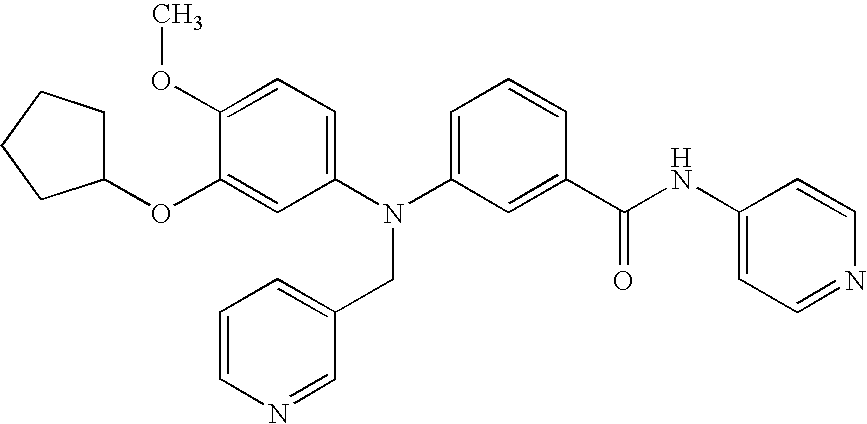3-aminobenzamide compounds and vanilloid receptor subtype 1 (VR1) inhibitors
a technology of vanilloid receptor and 3aminobenzamide, which is applied in the field of 3aminobenzamide compounds, can solve the problems of no effective analgesic agent and severely restricted use of narcotic analgesics, and achieves reduced side effects, reduced use of narcotic analgesics, and improved analgesic effect.
- Summary
- Abstract
- Description
- Claims
- Application Information
AI Technical Summary
Benefits of technology
Problems solved by technology
Method used
Image
Examples
example 1
Preparation of N-(4-tert-butylphenyl)-3-[N-(3-chloropyridin-2-yl)-N-methyl-amino]benzamide hydrochloride salt
Step 1
Preparation of Methyl 3-(tert-butoxycarbamide)benzoate
[0329]Methyl 3-aminobenzoate (3.02 g) was dissolved in tetrahydrofuran (30 mL), triethylamine (2.79 mL) and di-tert-butyl dicarbonate (4.47 g) were added, and the mixture was stirred at room temperature for 1 hour. The reaction mixture was partitioned between ethyl acetate and water, and the ethyl acetate layer was washed with a saturated brine, dried over anhydrous sodium sulfate and concentrated. The obtained residue was purified by silica gel chromatography (n-hexane:ethyl acetate=2:1) to obtain the title compound (2.86 g).
Step 2
Preparation of Methyl 3-(N-tert-butoxycarbonyl-N-methyl)aminobenzoate
[0330]Sodium hydride (60%) (530 mg) was suspended in tetrahydrofuran (5 mL), and a solution of methyl 3-(tert-butoxycarbamide)benzoate (2.86 g), which was obtained in the preceding step, in N,N-dimethylformamide (20 mL) w...
example 2
Preparation of N-(4-tert-butylphenyl)-3-[N-(pyridin-2-yl)-N-methyl-amino]benzamide hydrochloride salt
[0335]The similar reaction was performed in the step 6 of Example 1 using 2-bromopyridine instead of 2,3-dichloropyridine to obtain the title compound (373 mg).
example 3
Preparation of N-(4-tert-butylphenyl)-3-[N-(3-chloropyridin-2-yl)-N-ethyl-amino]benzamide
Step 1
Preparation of Methyl 3-(3-chloropyridin-2-yl)amino-benzoate
[0336]Methyl 3-aminobenzoate (1 g) was suspended in toluene (10 mL), 2,3-dichloropyridine (890 mg), tris(dibenzylideneacetone) dipalladium (275 mg), 2,2′-bis(diphenylphosphino)-1,1′-binaphthyl (450 mg) and cesium carbonate (2.94 g) were added in this order, and the mixture was stirred overnight at 80° C. After the reaction mixture was allowed to cool, ethyl acetate-water was added, insoluble substances were filtered off, the reaction liquid was then partitioned, and the obtained ethyl acetate layer was washed with a saturated brine, dried over anhydrous sodium sulfate and concentrated. The obtained residue was purified by silica gel chromatography (hexane:ethyl acetate system) to obtain the title compound (320 mg).
Step 2
Preparation of Methyl 3-[N-(3-chloropyridin-2-yl)-N-ethyl aminobenzoate
[0337]Methyl 3-(3-chloropyridin-2-yl)amin...
PUM
| Property | Measurement | Unit |
|---|---|---|
| temperature | aaaaa | aaaaa |
| temperature | aaaaa | aaaaa |
| pH | aaaaa | aaaaa |
Abstract
Description
Claims
Application Information
 Login to View More
Login to View More - R&D
- Intellectual Property
- Life Sciences
- Materials
- Tech Scout
- Unparalleled Data Quality
- Higher Quality Content
- 60% Fewer Hallucinations
Browse by: Latest US Patents, China's latest patents, Technical Efficacy Thesaurus, Application Domain, Technology Topic, Popular Technical Reports.
© 2025 PatSnap. All rights reserved.Legal|Privacy policy|Modern Slavery Act Transparency Statement|Sitemap|About US| Contact US: help@patsnap.com



